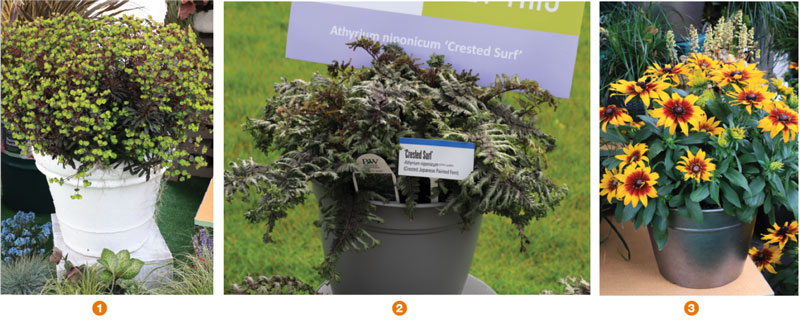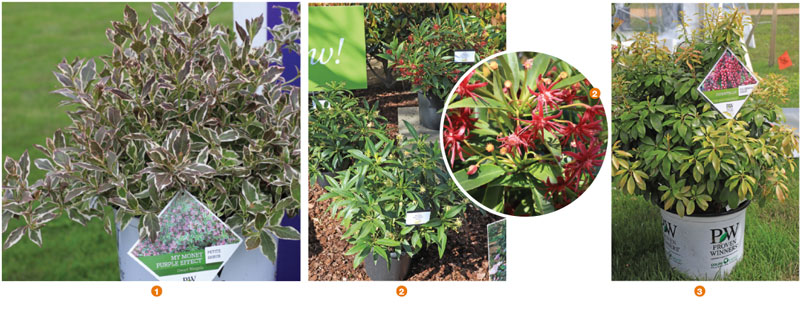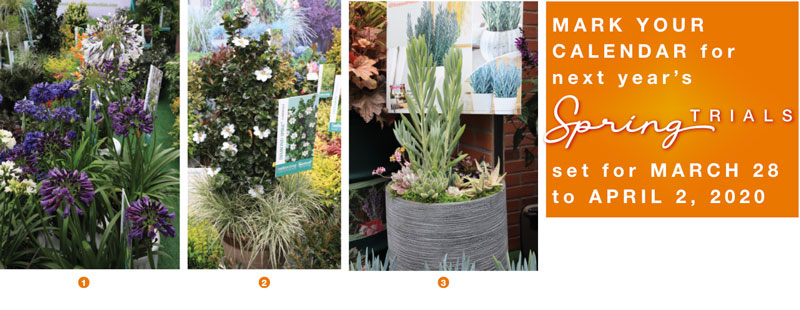8/1/2019
The Cali Tally, Part 2
Jennifer Zurko, Paul Pilon, Ellen C. Wells & Chris Beytes
Plenty of Perennials

1. Euphorbia Miner’s Merlot (Pacific Plug & Liner)
Miner’s Merlot has some of the darkest foliage we’ve seen on an E. purpurea variety with lime-green flowers. It boasts several desirable traits, including drought- and heat-tolerance (it’s a water-wise plant) and good vigor. They say it’s hardy to Zone 6, but they’re conducting more trials on hardiness to see if it can go lower.
2. Athyrium Crested Surf (Proven Winners)
Proven Winner’s new Japanese Painted Fern is a Zone 4 shade-lover that features a more vigorous habit and richer variegation than typical Japanese ferns; in addition, they sport an interesting split at the end of each frond.
3. Echibeckia Summerina Blazing Fire, Sizzling Sunset (Pacific Plug & Liner)
Echibeckia is a cross of two popular perennials that carry characteristics of both: the look and fast growth of rudbeckia, and the disease-resistance and durability of echinacea. They added two to their collection: Blazing Fire (pictured) and Sizzling Sunset. They’re pretty similar, with Blazing Fire having a more mounded habit than the more upright Sizzling Sunset. Both are bred by Bart Noordhuis. Zone 7 to 9.
 4. Dianthus Rockin’ Rose, Pink Magic, Purple (Kieft Seed)
4. Dianthus Rockin’ Rose, Pink Magic, Purple (Kieft Seed)
You've likely already seen Rockin' Red in the marketplace; Rockin' Red is no longer a solo act as three new Rockin' Dianthus colors join the band. Like their predecessor, all three have vivid colors, durable performance and great shelf/landscape appeal. Hardy to Zone 5.
5. Leucanthemum Madonna (Kieft Seed)
Leucanthemum is a tricky crop to breed, we’re told, which is why there’s always such variability with each variety. But Kieft says this one is extremely uniform. Hardy to Zone 4.
6. Nepeta Blue Prelude (Darwin Perennials)
This first-year flowering hybrid nepeta has large blue flowers and is great at attracting pollinators into the landscape. Blue Prelude blooms about the same time as other nepetas (late spring/early summer), but unlike the others it blooms for months. In the landscape, it grows about 30-in. tall and wide (it'll be smaller in containers—particularly the first year) and is hardy to Zone 5a.
 7. Sedum Prima Angelina (Darwin Perennials)
7. Sedum Prima Angelina (Darwin Perennials)
Jared Hughes, the breeder of Canary Wings Begonia, seems to enjoy plants with chartreuse foliage. He didn’t disappoint when he selected Darwin’s new sedum introduction. Prima Angelina is more compact than the original Angelina and others on the market, and has a very intense color that turns to gold in the winter, giving it year-round interest. Hardy to Zone 4a.
Leucanthemum 8. Double Darling Daisy, 9. Betsy (Green Fuse Botanicals)
Double Darling Daisy, the first fully double leucanthemum, is quite compact, but with pure white, fully double flowers. It’s part of Green Fuse’s “First Look” offerings, meaning it’s only available in small numbers for the coming season. Betsy, meanwhile, features the largest flowers you may ever see on a leucanthemum—upwards of 6-in. across. She accomplishes this great task without the need for vernalization or long days. This is a great Zone 4 shasta daisy for large containers or the landscape.
Chic Shrubs

Hellebore Winter Angel Charmer, 1. Dorothy’s Dawn (Pacific Plug & Liner)
Charmer is the earliest hellebore on the market, blooming at Christmas time or thereabouts; while Dorothy’s Dawn (pictured) is the latest, blooming sometime in March or even April, depending upon where you’re located. Both are bred by Dutch hellebore specialist Bart Noordhuis. Zones 5 to 8.
Heuchera Little Cutie Shimmer, 2. Northern Exposure Sienna (Terra Nova)
Little Cutie Shimmer gets no bigger than about 6- to 8-in. tall and 10- to 12-in. wide with a silvery sheen on its leaves. Northern Exposure Sienna (pictured) is a Zone 3 plant that can handle the harshest winter temps, but apparently it breezed through 116F conditions in Sydney, Australia, last year. And it’s pretty, too, with a red-veined lime leaf.
3. Heucherella Indigo Frost (Terra Nova)
Their new Indigo Frost is the first mini heucherella, has near-chocolate leaves and packs a punch on an 8-in. frame. Tough plant!
4. Digitalis Arctic Fox Rose (Darwin Perennials)
Arctic Fox is unique because it’s an interspecies hybrid that has the unique color of those novel interspecific types such as digiplexis, but with much-improved cold tolerance—Zone 5a, they say, compared to Zones 7 to 8 for “regular” hybrids. The only downside is that they don’t have any more colors coming from this specific breeding line. But take heart: they’re working on more crosses to bring you more variety.
5. Brunnera Jack of Diamonds, Queen of Hearts (Proven Winners)
At first glance, these brunnera are pretty similar, but Jack of Diamonds has more of a green pattern, while Queen of Hearts is predominantly silver-leaved. Big, big leaves at 9 to 11 in. in size, and both are resistant to leaf spot. Chris lamented the fact their pretty forget-me-not-esque blue flowers are confined to such a short time in spring. Zone 3.
 1. Weigela My Monet Purple Effect (Proven Winners)
1. Weigela My Monet Purple Effect (Proven Winners)
It’s a long name for a pretty variegated shrub that they call an improvement over My Monet. It’s a bit faster to grow, flowers better and its narrow white variegation is a bit less prone to burn.
2. Illicium Orion, Scorpio (Star Roses and Plants)
Two new and interesting Star Flower shrubs for part-shade areas of the garden. Scorpio is red, Orion is white. Drought-tolerant and hardy in Zones 5 to 8.
3. Pieris Interstella (Proven Winners)
Also known as lily of the valley shrub, their version—called Interstella—has a bicolor flower, grows to about 5-ft. tall and is a deer-resistant broadleaf
evergreen.
 4. Rose Pretty Polly Collection (Star Roses and Plants)
4. Rose Pretty Polly Collection (Star Roses and Plants)
Star says there’s a void in the market for these polyantha-type roses, so they’re introducing three colors: White, Pink and Lavender. They’re hardy, but they also do well in the heat of the southern states. Zones 4 to 9.
5. Rose Ringo (Proven Winners)
This landscape rose’s blooms change from yellow to white with a pink eye. Mildew and black spot-resistant, it grows to about 3 to 4 ft. Very hardy—down to Zone 3.
6. Rose Sunrosa Yellow Delight (Suntory)
Self-cleaning and holds its beautiful bright yellow color all the way through the seasons.
7. Rose Candy Sunblaze (Star Roses and Plants)
A novel flower color with a striped pattern, this plant can be used in the garden and as an indoor gift plant. Zones 4 to 9.
Potted Plants
 Cyclamen from Morel
Cyclamen from Morel
The French cyclamen breeder has a new series called Indiaka. Named for an international game played with a feathered shuttlecock (which the flower somewhat resembles), 1. Indiaka has interesting flowers that fade from White to Salmon, Rose, Bright Purple and Magenta. The series is a midi size, and comes with nice POP and even a consumer website, indiaka.cyclamen.com.
2. Morel is hoping their new Halios Rebelle will “rejuvenate how you see red cyclamen.” Two new reds in Rebelle—Red and HD Red (HD meaning it’s early
and ideal for high-density production). With excellent uniformity and heat tolerance, it has small leaves with rounder, wider and larger petals.
3. Success, part of their Latinia collection, gets three new colors: Neon Rose, Deep Salmon and Candy Pink. Early and easy, it’s a uniform series for 4- to 6-in. production.
4. Cyclamen Donatello (Schoneveld)
A mini type (2.5 to 4 in.) that’s great for summer production, this is a silver-leafed series that starts with seven colors.
 5. Gerbera Color Bloom (PanAmerican Seed)
5. Gerbera Color Bloom (PanAmerican Seed)
Color Bloom’s foliage is smaller and less leafy, so the flowers, which sit up high, really stand out. Add to it colors that don’t fade and an early finish time (seven to 10 days sooner than the competition), and this new series of five colors is one you should consider if you’re in the market for compact (quart-size) gerberas.
6. Kalanchoes from Beekenkamp
They’ve recently partnered with Dutch kalanchoe breeder and producer Slijkerman-Kalanchoë on production and distribution of kalanchoes for the North American market, and hence had a big display of them. They showed just a portion of Slijkerman’s 25-or-so years of kalanchoe breeding. Their main series is called Diamonds, with flowers offered in both single and double form—the bright red Lipstick being the most popular of the bunch. A new series is the all-double Serenity (pictured), whose uniformity across 15 colors is due to the fact that they’re all mutations from one plant.
Mums from Dümmen Orange
Dümmen Orange showed us several intros in the Breeze series of reliable, everyday-approachable single-flower mums: 7. Pink, Jam and—our favorite color—Fox Orange.
8. In cushion-flowered pot mums, the “more luxurious” series Chrystal gets four new colors: Romance, Bumblebee, Bronze Bicolor and Blush.
9. In the category of fall-appropriate pot mums they offered the orange and yellow-striped Rainbow Circus (pictured) and the very “football mum-ish” incurve mum Cosmo Bordeaux.
A few more to consider…
 New intros from Sunset/Southern Living Magazine
New intros from Sunset/Southern Living Magazine
These started out as branded woody ornamentals grown by some select nurseries participating in the program, but has expanded into perennials and even annuals. In fact, Skagit Horticulture is now producing liners of those and making them available to any broker that wants them, which means any grower or grower/retailer can get these genetics. It’s impressive that many of the varieties are in both magazine programs, meaning they perform well in both the dry Mediterranean west and the steamy tropical South. That’s the case of these three intros:
1. Diamond Spire Gardenia is a columnar gardenia that grown to 3.5- to 4-ft. tall.
2. Agapanthus Ever is a collection of early reblooming agapanthus in four colors, including a nice bicolor called Ever Twilight.
3. Senecio Skyscraper is “blue chalk sticks on steroids,” offering fast-growing height for succulent containers.
 Succulents from Jaldety
Succulents from Jaldety
4. Senecio Silvery Velvet is a big, fluffy Dusty Miller. It’s not one of those giant-leafed senecios that looks almost prehistoric, but it’s still impressive, with nice proportions. A tip: it doesn’t like shade. Full sun gives you the best habit.
5. Sedum Silver Roses is a pretty little sedum suited to dangle over the edge of a mixed succulent container.
6. Delosperma Jewels of Desert is one of those nice little blooming rock garden succulents that you can plant and forget … until it blooms with all its colorful, iridescent flowers. GT